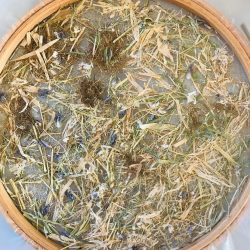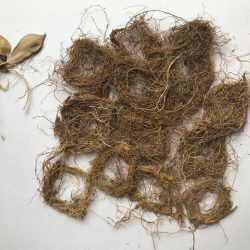Paper making with grass pea

A plant important to subsistence farmers and a focus of research here at the John Innes Centre, is now being explored for its creative potential in paper making.
Towards the end of 2019 textile artist and M.A. Textile Design student on the course at Norwich University of the Arts, Caroline Hyde-Brown, inspired by artists such as Diane Scherer who uses roots in fashion, was looking to develop using plants in her practice. Caroline met with Dr Anne Edwards, who works on grass pea (Lathyrus sativus) and there sparked the beginning of their collaboration.
The little known plant is a durable crop, surviving situations including drought, flooding and high salinity, where other plants perish. It is also highly nutritious – high in protein while low in fat. But this crop has its limitations. It contains a neurotoxin, B-ODAP, which if eaten to excess, for example during times of famine when it becomes the main source of food, can cause lathyrism and even paralysis.
Dr Anne Edwards, along with colleague Dr Abhimanyu Sarkar are working to produce varieties of grass pea that produce reduced amounts of the toxin and are therefore safe to eat.
Captivated by this remarkable plant, Caroline set to work using plant material leftover from experiments, in close collaboration with Anne and Abhi. Previously unaware of grass pea, Caroline has found that “the more research that I’ve done and the more I’ve looked at the plant and spoken to Anne and Abhi, the more I’ve learnt”.
Approaching grass pea from a textile viewpoint was also new for Anne “This has been all very new to me (though I did try nettle cordage once)”.
Initial experiments together produced exciting results. Building on these Caroline has used grass pea from the roots to the flowers to produce a diverse a variety of paper and plant-based surfaces including fabrics as well as objects such as bowls.
Caroline is motivated by the whole systems approach in sustainable textiles. The concept being that by making the production of textiles simpler, it impacts on the wider sustainability of the textile industry. Caroline explains, “I consider the ‘interrelatedness of both problems and solutions’ which will hopefully result in the development of new and creative ways to overcome the challenges associated with sustainable design”.
In line with this, the team used primarily heat and water to produce the textiles.
This simplicity also brings another advantage. Production is accessible and does not require specific or technical equipment. The team are keen to share the expertise that they have developed for grass pea textiles with grass pea farmers, as this could increase the income for subsistence farmers, and the simplistic method would make this achievable.
Abhi states that, “Developing and producing artisanal products from grass pea crop residues can be a very important means of earning extra money for some of the most deprived and marginalised farmers in the Indian subcontinent and Africa”.





















